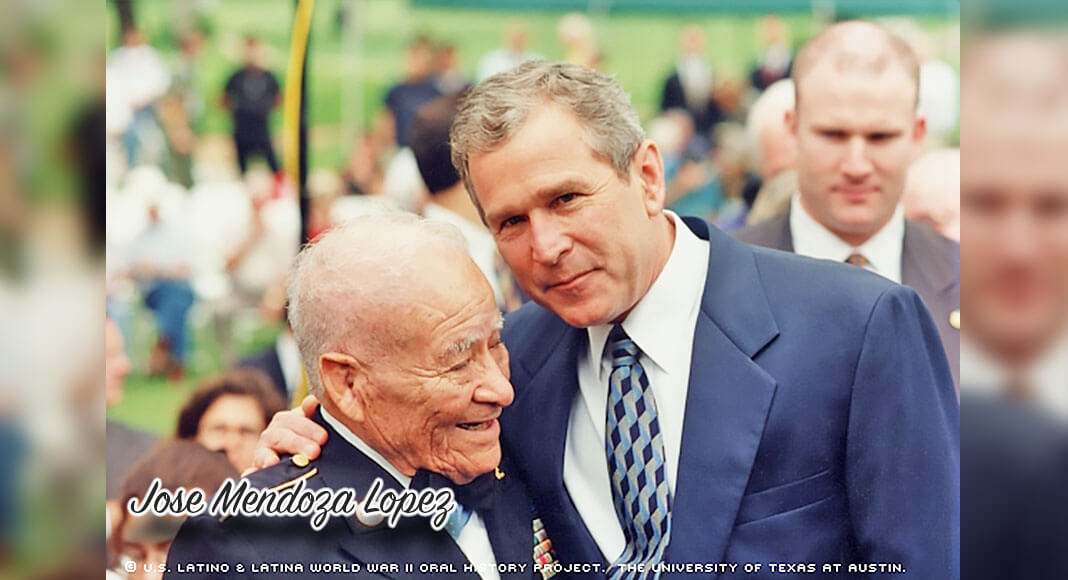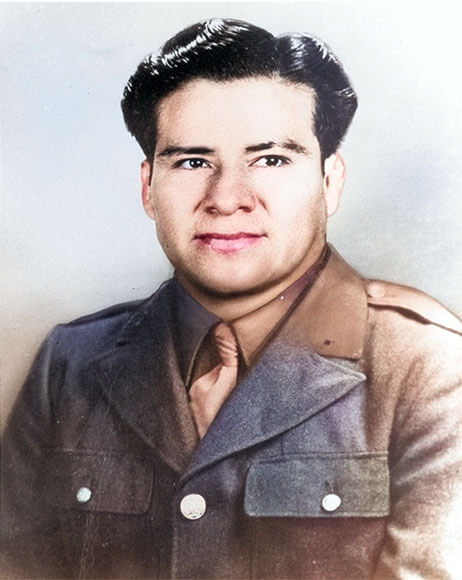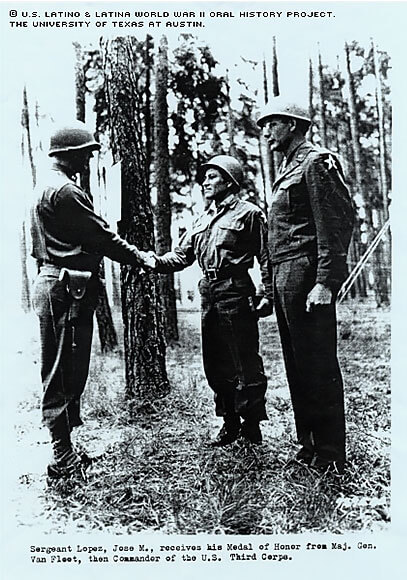
Texas Border Business

JOSE MENDOZA LOPEZ (1910–2005). Jose Mendoza Lopez, Medal of Honor recipient, was born on July 10, 1910, the son of Cayetano and Candida Mendoza de Lopez. Although military records list his birthplace as Mission, Texas, he was born in Santiago Atitlán, Mexico. In 1935 he purchased a false birth certificate in order to join the United States Merchant Marine. His early years were difficult. Lopez never knew his father and had been told by his mother that he had drowned. After his mother’s death from tuberculosis when he was eight and with no way to support himself, the boy headed to the Rio Grande Valley. As a youngster, Lopez attended little school and worked in the cotton fields around Brownsville to support himself while living with an uncle or other friends.
In his teens, Lopez hitched a ride on a freight train and ended up in Atlanta, Georgia. A local boxing promoter, impressed with Lopez’s athleticism, arranged some amateur fights for the youngster. Needing shoes, Lopez turned professional. From 1927 to 1934 Lopez, billed as “Kid Mendoza,” compiled a record of fifty-two wins and three losses in the lightweight division. Years later, he stated that the highlight of his boxing career was when he shook hands with Babe Ruth in Atlanta before a bout.
From 1935 through 1941 Lopez found employment in the Merchant Marine working on ships and traveling the world. After a period of employment in Hawaii, he was on a ship headed to the United States when he heard of the Japanese attack on Pearl Harbor on December 7, 1941. After his arrival in California, authorities wanted to arrest him until he convinced them he was Mexican not Japanese.
In 1942 Lopez returned to Brownsville and married his girlfriend, Emilia Herrera; she was his wife of sixty-two years until her death in 2004. Together they had four daughters and a stepson from his wife’s previous marriage. With his wife’s support, he enlisted in the United States Army and spent a brief time at Fort Sam Houston in San Antonio before going to Camp Roberts (California) for basic training. Assigned to Company K of the Twenty-third Infantry Regiment, Second Infantry Division, Lopez’s unit trained in Northern Ireland where it prepared for the Allied invasion of Nazi-occupied Europe—D-Day.
Described as short and stocky, the five-foot-five, 130-pound Lopez excelled in combat. Assigned to a weapons platoon, he set foot in Normandy on June 7, 1944. Although wounded on D-Day plus 1, Lopez refused treatment and evacuation and was determined to remain with his unit. He participated in the hedgerow action near Saint-Lô, the fight to take Brest, and was involved in steady combat in France and Belgium for the rest of 1944. For his efforts, Lopez was awarded a Purple Heart and a Bronze Star.

On December 17, 1944, Sergeant Lopez witnessed the Germans launch their offensive in the Ardennes against Allied forces in the Battle of the Bulge. Situated with Company K near Krinkelt, Belgium, Lopez took action on his own. Holding a heavy machine gun, Lopez found cover in a shallow hole and positioned himself. Taking aim at the soldiers surrounding a German Tiger tank, he immediately fired and killed ten of the enemy. Despite enemy fire from the tank, Lopez held firm and killed twenty-five additional Germans who were attempting to outflank him. He avoided blasts from the tank until one landed close enough for the concussion to lift him off the ground and throw him backward. Lopez recovered quickly, avoided being outflanked by the Germans again, reset his weapon, and fired to protect Company K. Then, using the dense forest for cover and constantly on the move, Lopez continued to fire and kill Germans. Eventually he met up with a few of his fellow soldiers to establish another defense point, where he continued fire until his ammunition was exhausted. In an operation that lasted from 11:30 a.m. until 6:00 p.m., Lopez killed more than 100 enemy soldiers—more than any other American serviceman during World War II. His efforts stabilized the flank and provided time for his company to regroup which eventually caused the Germans to bypass Krinkelt.
In a ceremony in Nuremberg, Maj, Gen. James A. Van Fleet presented Jose Mendoza Lopez the Medal of Honor on June 18, 1945, for his “gallantry and intrepidity, on seemingly suicidal missions in which he killed at least 100 of the enemy, were almost solely responsible for allowing Company K to avoid being enveloped, to withdraw successfully and to give other forces coming in support time to build a line which repelled the enemy drive.”
With the end of the war in Europe, Lopez returned to Texas and worked for the Veterans Administration in San Antonio. Shortly after the war, upon a visit to Mexico City, he was honored with la Condecoracion de Merito Militar, Mexico’s highest award for military valor, by Mexican President Manuel Ávila Camacho. Lopez also took great pride when Mexican President Miguel Alemán Valdés invited him to Mexico City and honored him with the Order of the Aztec Eagle in 1948. In 1949 he reenlisted in the United States Army and was assigned to the Second Infantry Division.
At the outbreak of the Korean War in 1950, Sergeant Lopez returned to combat until a ranking officer, learning he was a Medal of Honor recipient, ordered him to the rear. For several months, he retrieved bodies and registered them for burial until being reassigned to Japan. Lopez remained in the military serving as a recruiter and working in a motor pool where he was responsible for its maintenance operations and crew. In 1973 he retired with the rank of master sergeant.
In retirement, Lopez remained active and spent time with his wife, children, and grandchildren in San Antonio. The Mexican-born Lopez also took the opportunity to talk with young people about his love for America. He found civilian employment, sometimes holding two jobs at a time. To stay in shape, Lopez jogged until he was eighty-eight and met with a physical trainer three times a week until early 2005. In January 2004 Lopez attended the inauguration of President George W. Bush; having attended earlier ones for: John Kennedy, Richard Nixon, Ronald Reagan, and George H. W. Bush.
In his final years, Lopez was hindered by frail health and used a walker. Before his wife’s death in 2004, he devoted much effort to taking care of her. On May 16, 2005, he died of cancer at the home of his daughter, Maggie Wickwire, in San Antonio. At the time he had been the oldest surviving Hispanic Medal of Honor recipient in the United States. Lopez, a Catholic, was buried with full military honors at Fort Sam Houston National Cemetery in San Antonio. Jose M. Lopez Middle School in San Antonio and Jose M. Lopez Park in Mission were named in his honor. A statue of Lopez also commemorates the veteran in Veterans Park in Brownsville.
Biography by Henry Franklin Tribe, Handbook of Texas Online
Published by the Texas State Historical Association











